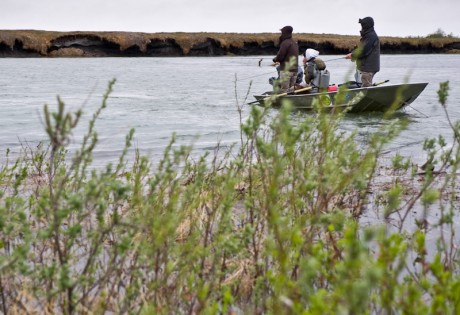
Super high, early season water in Western Alaska can mean our king salmon are less likely to hold on the gravel bars. That was the case in early 2012 and, though huge water years are not too common season-to-season, those who set foot on the tundra with an open mind can make some seriously fishy business transactions happen.
We were reminded of this during the Alaska West 2012 season’s legendary Week One, where a few guides and crittery anglers found more than a few Gagtrons that went Richter in a river that was so high it was pushing through the trees on most bars. How? By going Thunderdoming.
Thunderdome Rigs
Coined by veteran Guide Jeff Hickman, the term Thunderdoming was borne after Hickman happen to notice Kevin ‘KP’ Price and Jason Koertge leaving their normal two-handed arsenal back at camp and boarding KP’s boat with a quiver of 9’ 10 weights— not an uncommon rod choice for boat fishing, until you happened to notice the rigging on their rods.
In front of thin mono shooting lines, the two had looped on straight 20-foot coils of T-14, a 3-foot leader and giant, yet unweighted tube flies. Both KP and Koertge tried to keep maggotism this huge under wraps, but the amount of boat chases witnessed by the camp that day couldn’t possibly have gone unnoticed. They, along with Alaska veteran Marty Herman, were into their share of chinook. And then some.
Back at camp, KP’s beans were forcibly spilled that evening at the pre-dinner guide meeting. Koertge just vanished but was found later that night in his tent, furiously constructing more 20’ coils of T-14.
How You Fish It
The beauty of a rig like this? Simple, down, and dirty effectiveness. Level 20-foot sections of T-14 could load a 9’ 10 wt. easily and comfortably single-hand cast a mile from the elevated position of a boat. What’s more, casting 50° down and across into a slow-moving slough set the swing up perfectly for the mono shooting lines to quickly take that T-14 down into Chinookville.
The real effectiveness of the rig shined on the hang down, that period where your line is straight below you. By anchoring on the seam—right where the kings were holding, the mono and sinking lines held the flies down in the sweet zone despite the heavy current. And while takes often came on the swing, easily 2/3 of them came when slowly stripping the flies back and briefly pausing—the kind of violent, arm-crippling grabs that have to be witnessed to be fully comprehended in a “WTF was that?” kind of way.
All that said, next time you’re up in Tundra Country and the water looks a little too high and fast over your favorite gravel bar, don’t be surprised to find yourself anchored in the sloughs or outside bends with a Thunderdome rig ready to rage. Also, remember to pause for a second or two after each hang down strip. It’s seriously the way to fish slow, sloughy high water, but only if you’re the type of person interested in a bunch of kings that would love to dislocate your shoulder. As one might guess, most of our guests are.
No doubt about it…it works. I also tried Rob’s clouser and comet technique for fresh Kings in the slack water in Michigan this year, and it works great. Maybe you could get Rob to write the “clouser report” …the finer points, ie the smaller fly option for chinooks.
When the camp first moved down from Fox Bar in 1994 very little fishing was done off the bars. We fished kings from the boats with 400 grain teeny lines and 10-12 wt single handers. In 95 and 96 we really dialed in fishing from the boats in Tidewater. Then as the popularity of 2-handers took off and boat fishing went by the wayside. It’s a lot more effective most of the time because the fly really gets in the zone and stays there. Goes to show everything new was once old, no different than Bill Schadt fishing the mouth of the Smith in the 60’s, it’s all be done before.